The vine year
Of course, the course of a vine year can vary. The reason for this is the weather conditions, which have a greater or lesser influence on the course of the work in the vineyard. This calls for experience, flexibility, a talent for improvisation, patience and a good dose of composure on the part of the winegrower, who must constantly adapt his work in the vines to the changing conditions. Just as nature influences the course of a vintage year, it also determines the basic pattern of the associated work and development stages of the vines over the course of the year.
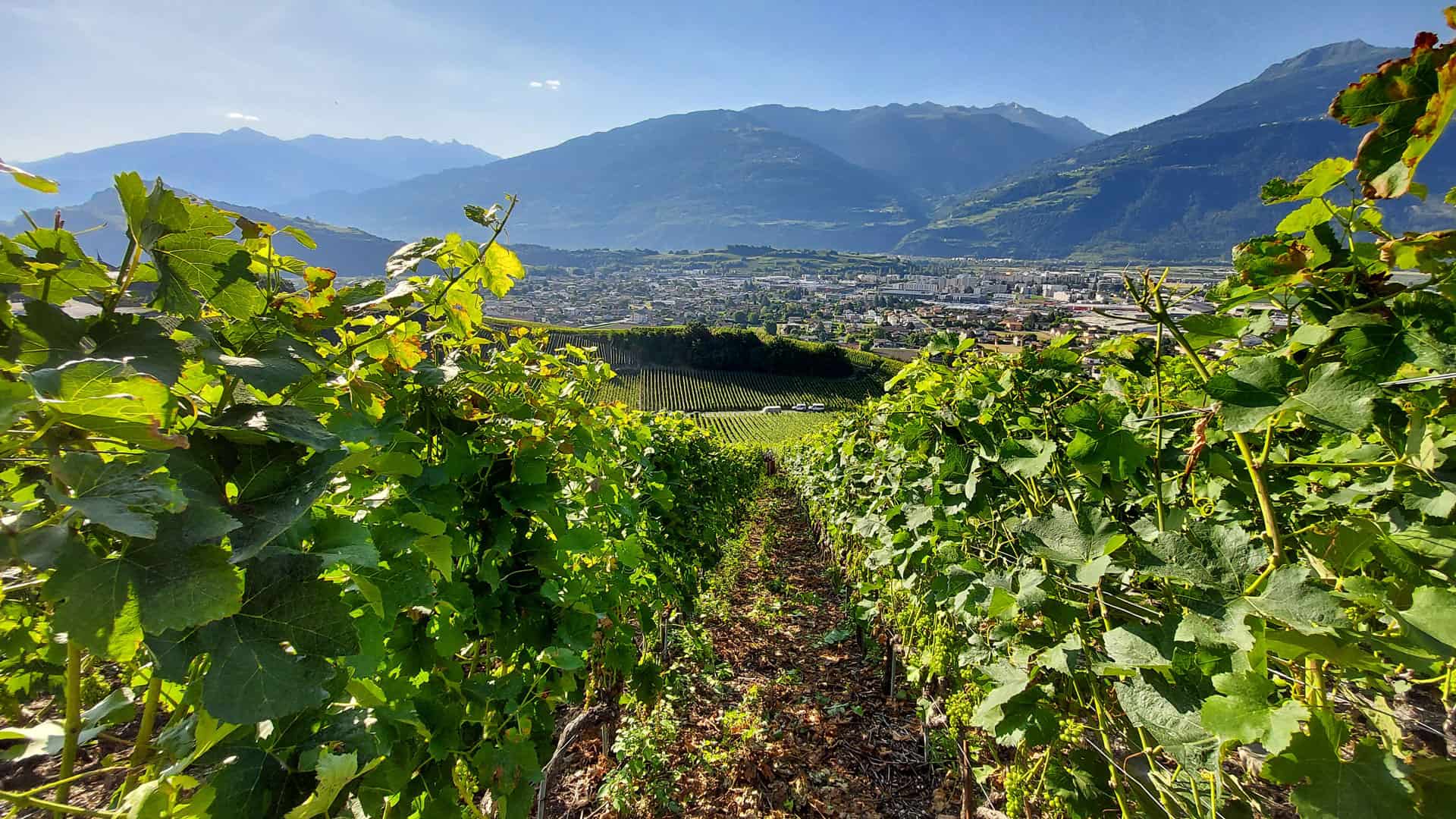
January
In January, the vineyards in the northern hemisphere are in hibernation. Cold days can be fatal for old and weak vines. Temperatures as low as -20° Celsius do not usually pose a threat to a healthy vine, provided such cold temperatures do not persist for too long. During this time, the winemaker focuses in particular on the development of the new vintage in his wine cellar.
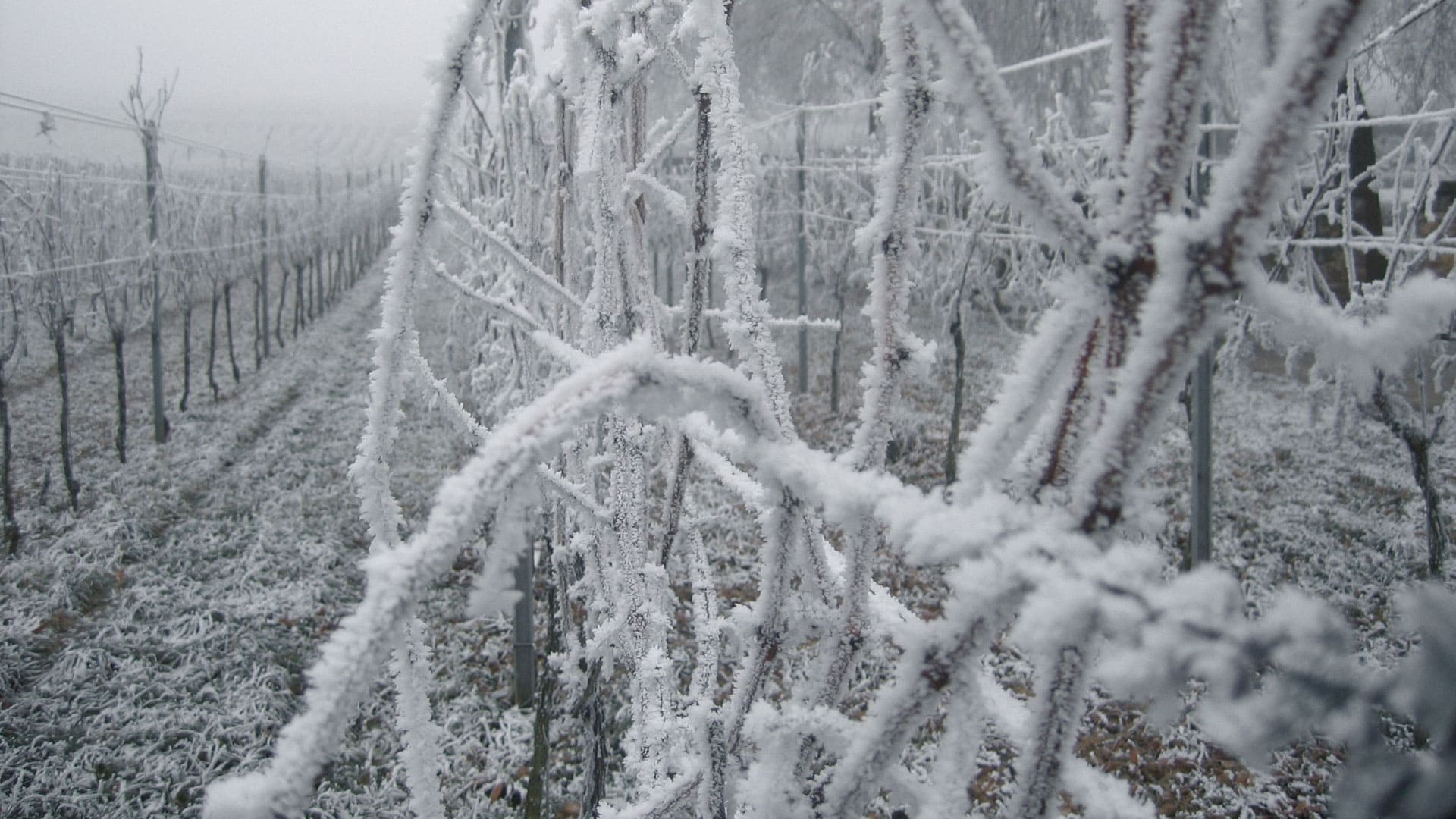
february
While the vines are still dormant in winter, pruning gradually begins. Vines belong to the climbing plant family. If they are not pruned, the vines proliferate. As a result, the number of grapes increases, which leads to a marked decline in quality. Vines must be pruned and trained in such a way that a balanced relationship between leaf mass and grape production is achieved.
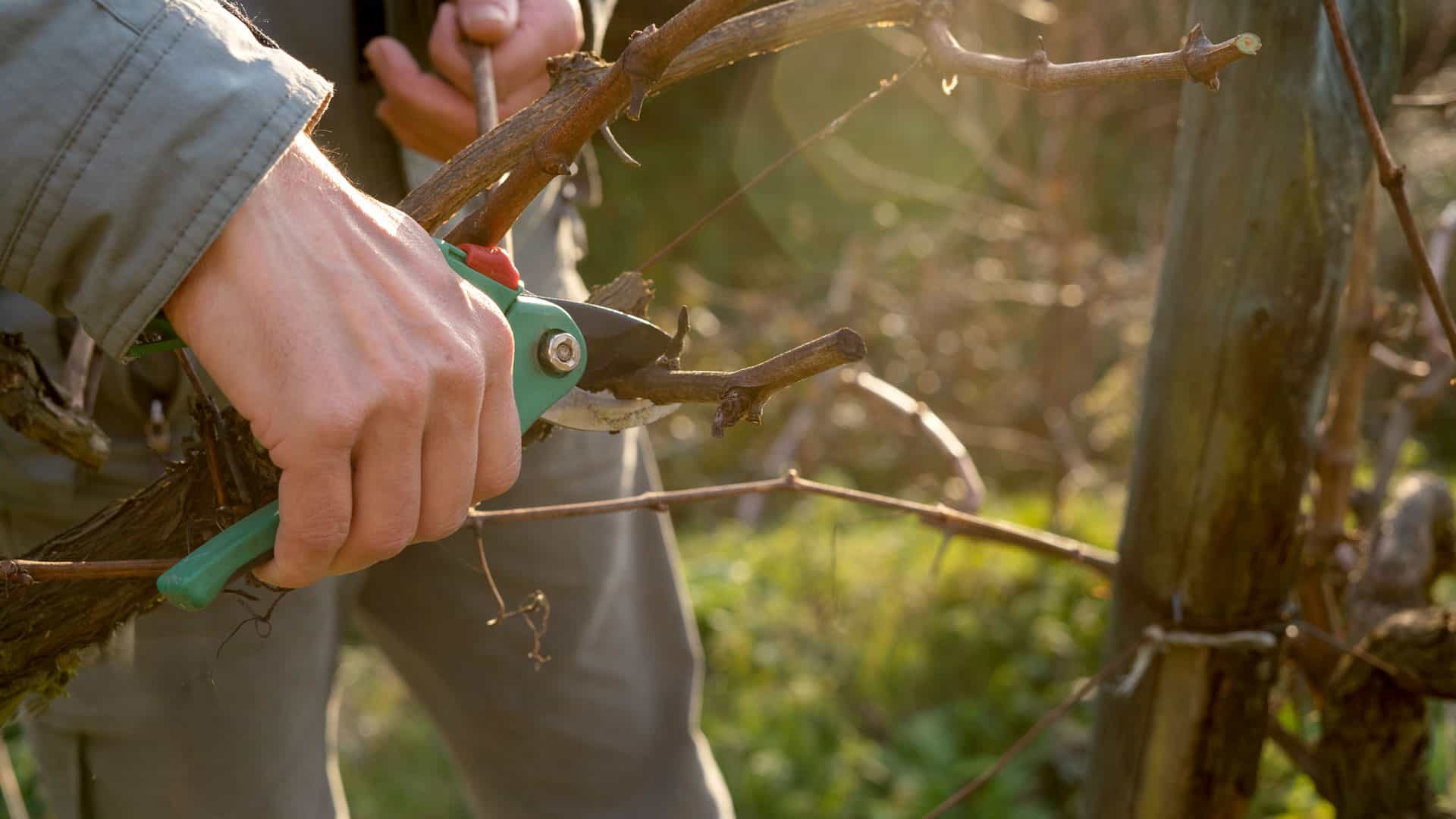
Common training systems are the Guyot, the traditional Goblet and the stretched arch pruning. In Valais, cordon pruning is preferred. In contrast to the stretched arch, two cordon arms are created on the wire, which remain intact for several years.
- When choosing an educational system, preference is given to the one that offers the
- The best way to achieve the goals of integrated production.
- Production of healthy grapes
- Long lifespan of the vines
- Protection against soil erosion
- Reduction of factors that promote the development of diseases and pests
- Effective application of crop protection products with as little drift as possible
- High biodiversity
Pruning, i.e. training the vine, involves a great deal of work and should be completed before the first buds appear. Grapes generally only form on one-year-old shoots that spring from two-year-old wood. If several shoots develop in the year of planting, leave the strongest one and tie it to the support stake. This means that all shoots except the strongest are cut away. This process is repeated in the spring of the following two years. The plant grown in this way develops a strong main shoot that resembles a small tree trunk.
Pruning objectives, pruning time, reserve cones and frost rods
By pruning the vines, the winegrower pursues four main objectives. Firstly, the process serves to regulate the yield and thus ultimately to improve the quality of the future wine. Secondly, it regulates the vine’s vigor and ensures that the vines are able to grow. Last but not least, pruning the vines serves to fundamentally maintain the cultivation system.
The time of pruning is of crucial importance. It is when the leaves have fallen off the vine, as by this time the sap has retreated into the roots. It is important to ensure that pruning does not take place too early, as unpruned vines are significantly better protected from a possible frost.
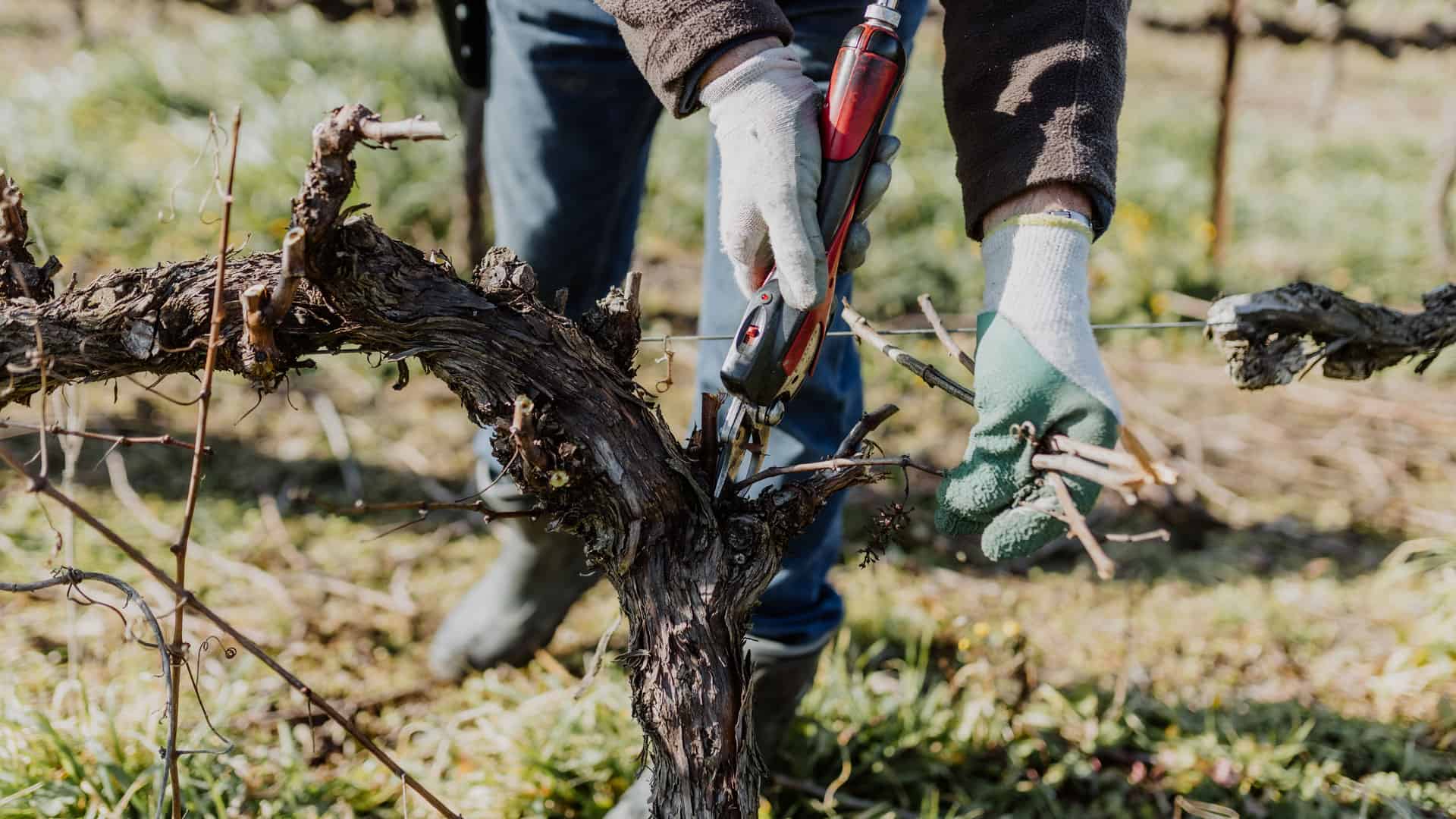
Correct pruning guarantees that the desired training form of the vine is maintained and that the trunk does not grow too tall. The pruning must be adapted to the respective vigor of the vine. As a rule, this means keeping six to eight eyes per plant. The so-called reserve shoots are then only left to sprout if another shoot fails to thrive. In cold locations with a high risk of frost, one or two of the shoots are usually not cut, as they tolerate frost better and can be used as a possible replacement if supporting canes freeze.
March
In March, the elaborate pruning is completed and the canes are tied up. As temperatures rise, the sap returns to the cane. The absorbed water reaches the tip and gradually drips out of the freshly cut eyes – in technical jargon this is known as “the vine weeps”.
This is also the time to start fertilizing the vineyard so that the plants are additionally strengthened with nutrients as they grow. Plant fertilization is based on knowledge of plant functions, their needs, their consumption and the mineral and organic nutrient reserves of the soil. The soil basically consists of 10 valuable microelements. In order to create optimal conditions for the vine, nutrients are added to the soil based on precise analyses to achieve a balance of these microelements.
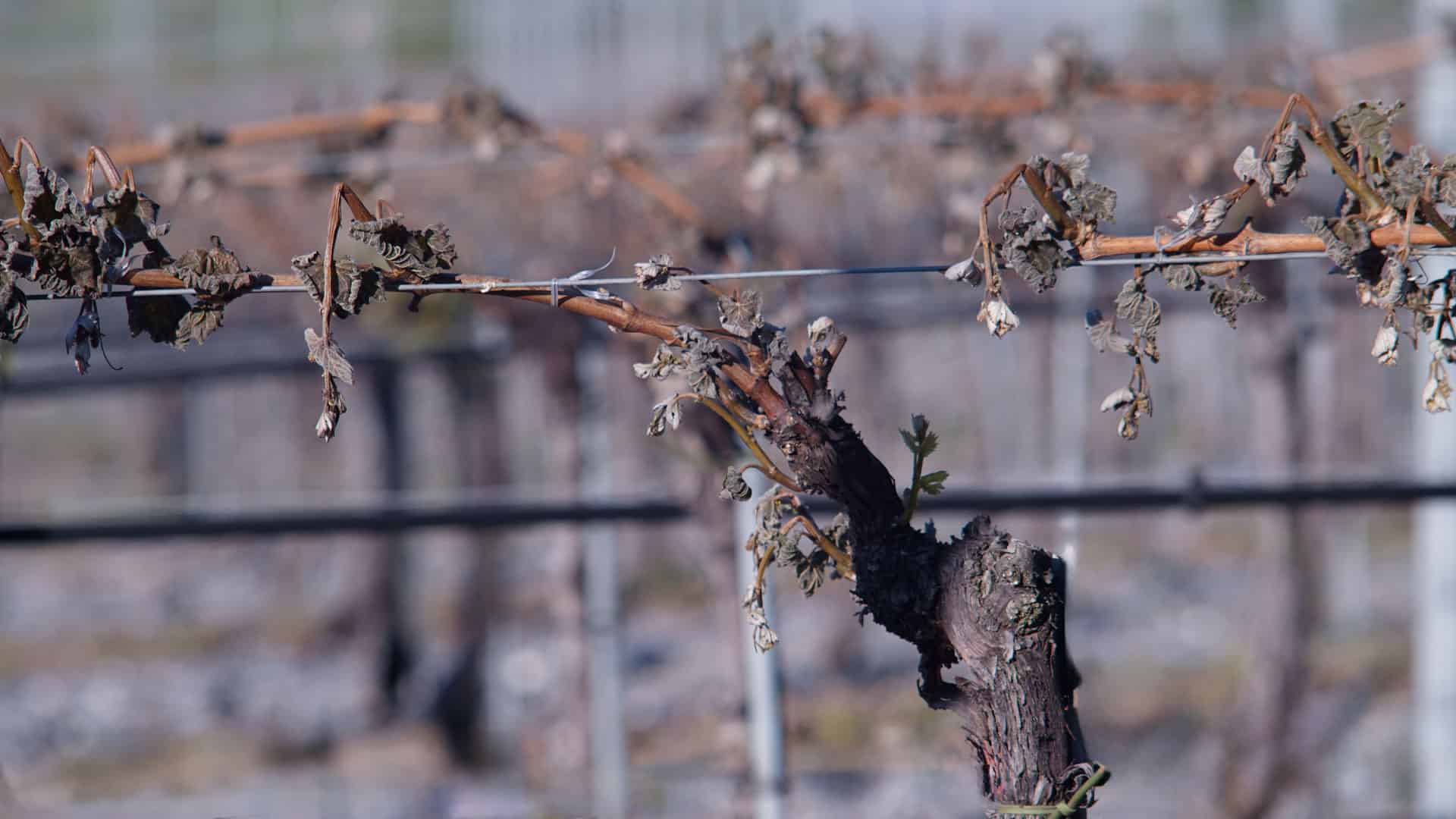
If viticulture is carried out according to the guidelines of integrated production (IP), special requirements must also be met. For example, fertilization – which should preferably use organic material – must be compatible with the production of high-quality grapes, the good health of the vines and the preservation of soil fertility. Fertilizers must not be applied to the vines indiscriminately or in unlimited quantities. Instead, the quantity to be applied must be based on soil analysis and plant assessment. This also means that the effective nutrient requirements of the vine, the type of greening and also the risk of leaching must be taken into account.
April
April Fool’s Day does what it wants. Even if it is just a common saying, there is still a certain amount of truth behind it. And so the moody and changeable April weather keeps winegrowers on their toes. While it can encourage budding one day, it requires frost protection measures in the vineyard the very next day. As the warm spring weather sets in, the vine’s metabolism kicks in. As a result, the buds swell. If you want to plant new vines, i.e. young vines, you should do so precisely at this time.
May
The merry month of May is a booster for the shoots. With its warm days, it causes the vine to sprout more than one meter within a month. This must be avoided and the shoots must be harvested early and excess shoots carefully removed by pinching. After pruning the vine at the beginning of the year, this measure is also aimed at regulating the yield in order to obtain healthy grapes of the best quality later on. In addition, this measure ensures that the later grapes receive much more sunshine and good aeration. Both promote sugar formation. Furthermore, pruning determines the further development of the vine and ultimately also promotes the balance of the entire vine. With the transition from spring to summer, the risk of pest infestation and disease also begins. This is the time to think about the appropriate use of plant protection products and measures. From this point onwards, it is important to regularly check the vines for possible infestation by pests or diseases. For this purpose, defined survey methods and tolerance limits are used. If the use of plant protection products is unavoidable, they must be selected in such a way that they do not endanger people or the environment, while still offering effective protection against pests, diseases or weeds. Gentle, biological or biotechnical control methods should always be given priority. The application technique used is understood to mean the choice of suitable equipment and consideration of the weather conditions. It ensures that the plant protection products are applied in an optimal and targeted manner without endangering the user or the environment.
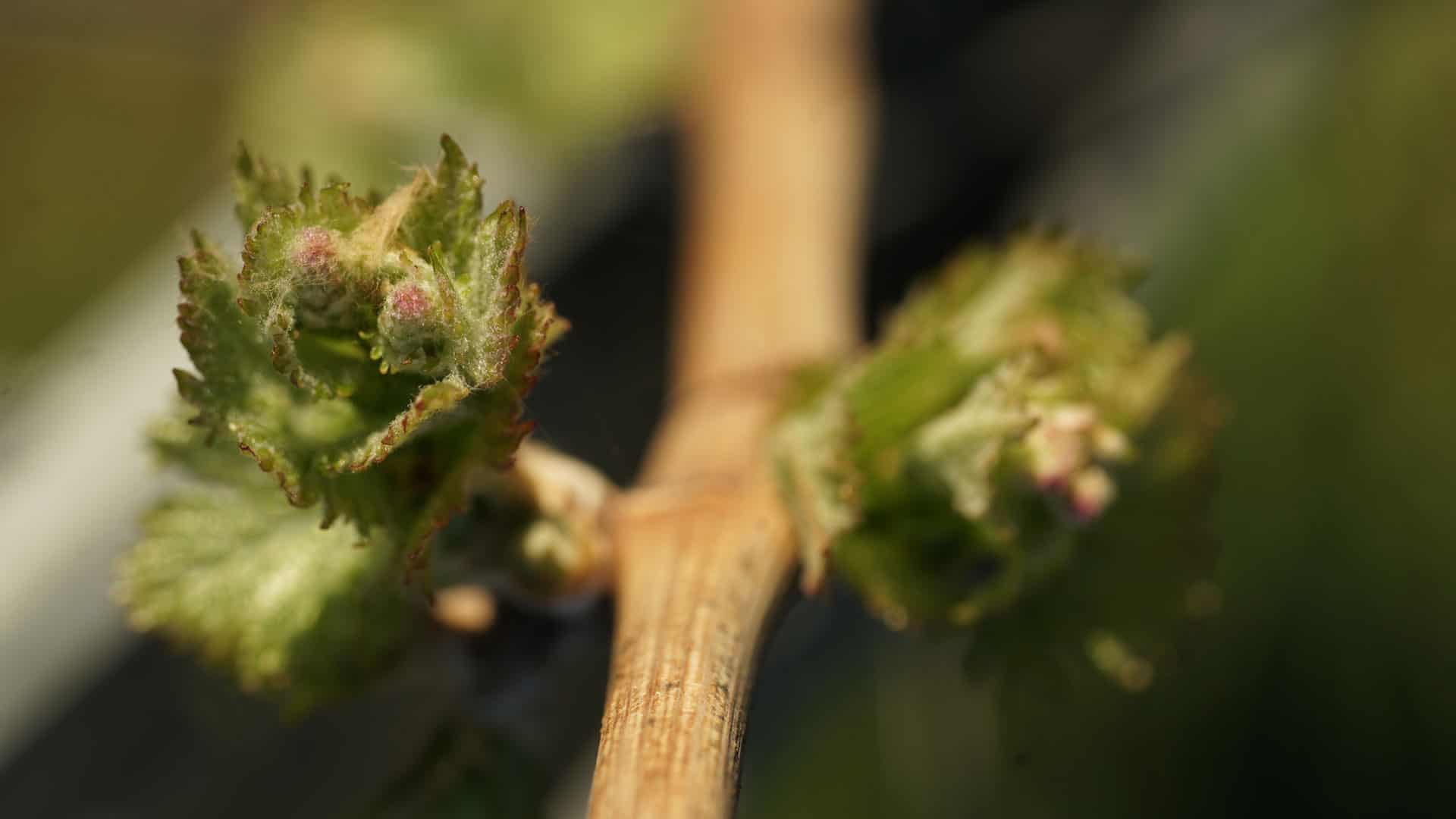
June
It is the month in which the vines are in bloom and shoot growth is in full swing. As soon as the young vine shoots reach the first stapling wire, they are looped or stapled. Depending on the training system, they are clamped between the double wire or braided alternately on the left and right. Braiding the shoots requires a lot of time and dexterity. Stapling is repeated when the next wire is reached.
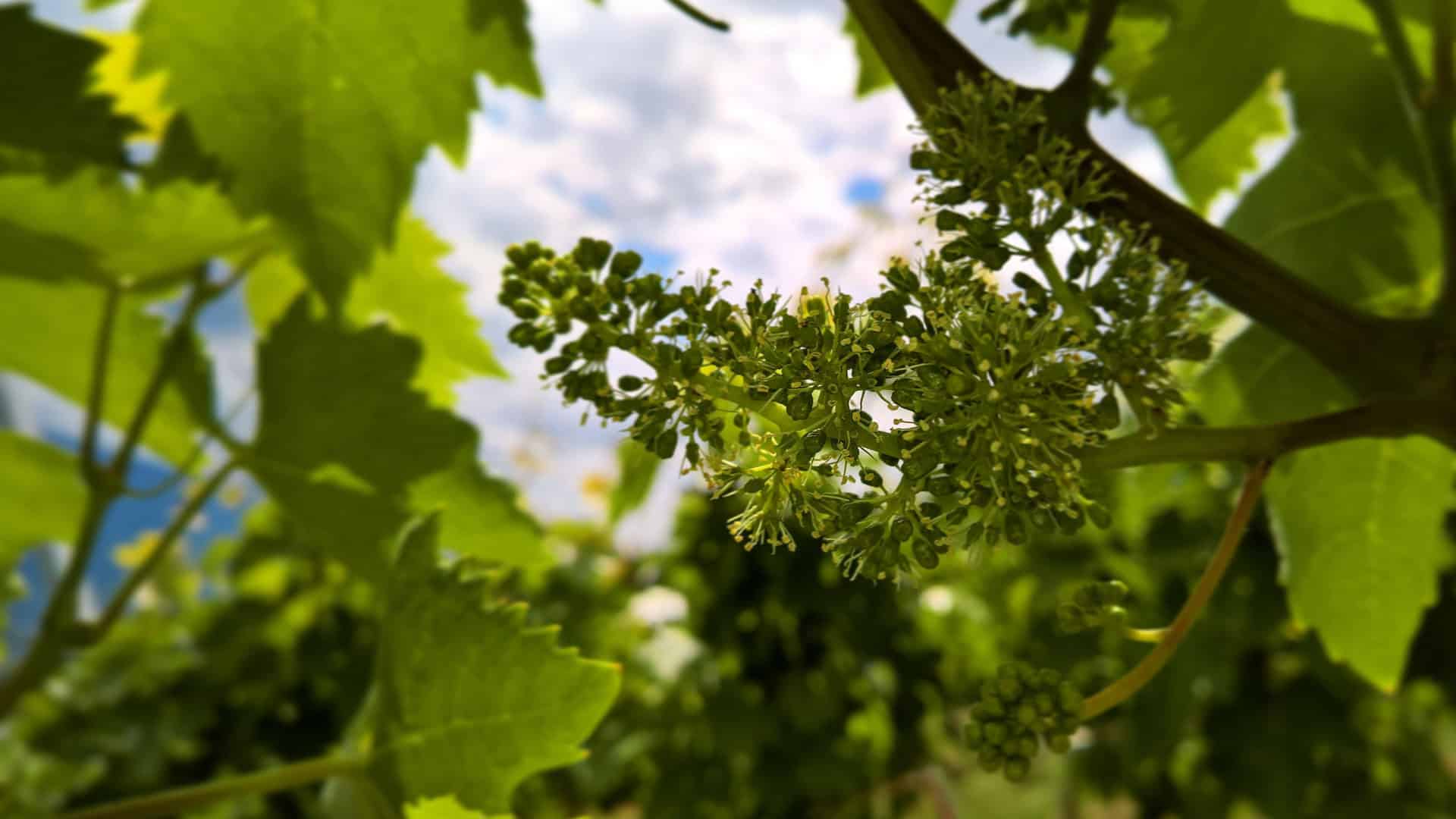
Soil cultivation is now also a priority. The aim is to create optimal conditions for the vines, protect the soil from erosion, prevent soil compaction and the leaching of nutrients and promote biodiversity. Suitable measures to prevent soil erosion include planting and covering the soil with compost, sawn timber or straw. If the vineyard is planted with young vines, their growth is encouraged by adding manure. The sawn timber also remains in the vineyard and strengthens the soil through composting. In order to accelerate decomposition, the pruning wood is increasingly cut into small pieces. As the soils in Valais are extremely poor, deep-rooted vegetation would deprive the vines of nutrients and water reserves. For this reason, this measure is not used in Valais.
July
During the hot summer days, the blazing sun limits the amount of water available. Even if the odd thunderstorm brings a certain amount of moisture, these phenomena also harbor the risk of devastating hail. It is therefore important to adapt the irrigation – ideally with drip irrigation, which eliminates the risk of nutrients being washed out – to the actual requirements. In principle, irrigation should only be limited to very dry areas, plants with little soil thickness or young plants, and the grapes must not be irrigated during the ripening period. As soon as the shoots have reached the top wire, the length growth of the shoots is broken by removing the shoot tip. This is done by shortening the tips with scissors so that they cannot slip out of the top wire in the wind. The earlier the process of length growth can be interrupted, the more valuable stingy shoots will sprout.
august
The formation of stingy shoots is stimulated by topping. The dominance of the shoot tip disappears and the valuable stingy shoots grow from the attachment points of the shoots. These are very important for the ripening of the grapes, as their young, strong leaves are able to export a lot of grape sugar into the berries. In the grape zones, stingy shoots hinder the aeration of the foliage, so they are removed early.
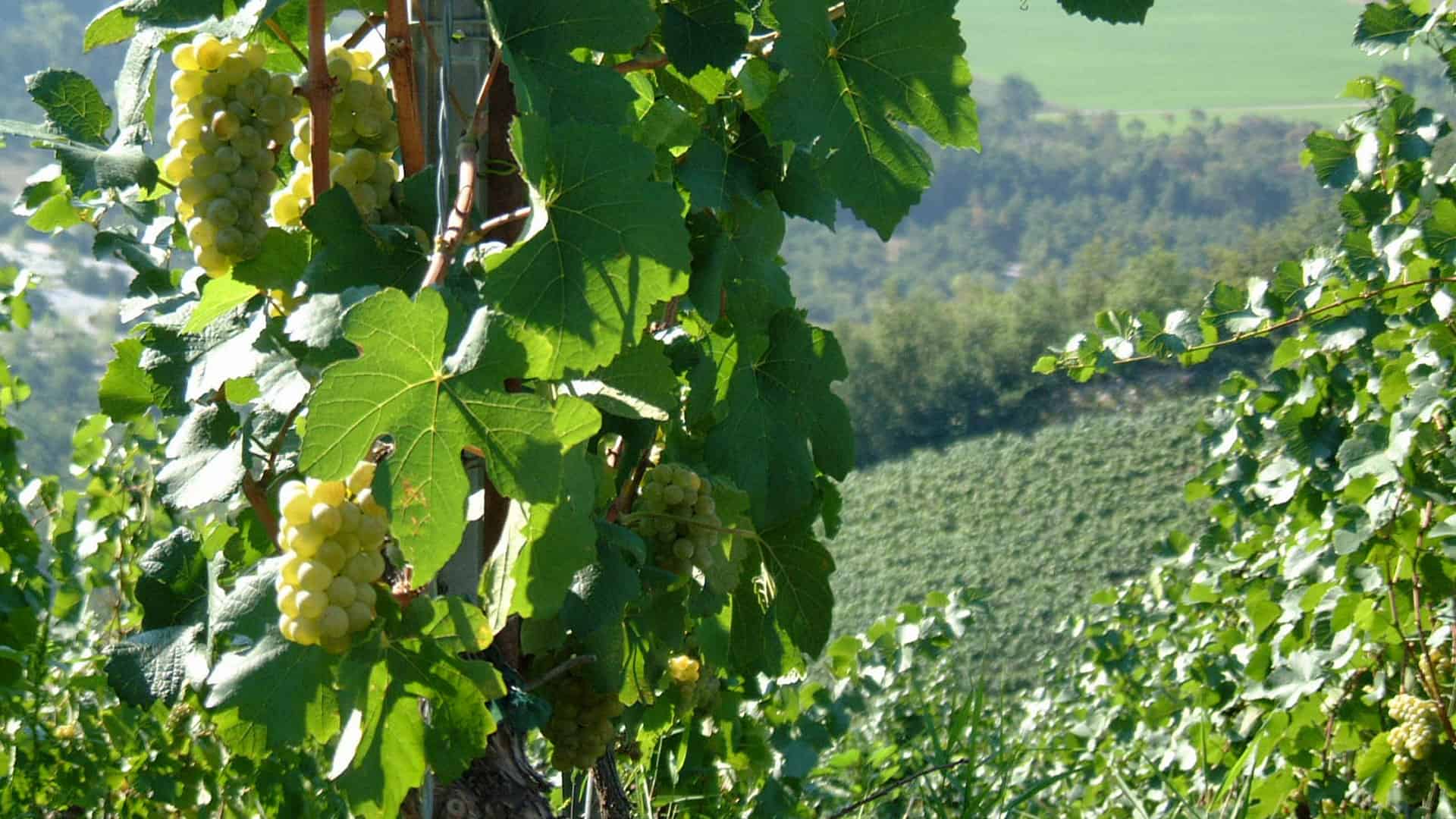
The foliage is also of existential importance to the plant. Its function is to produce glucose. The green leaf has the task of converting solar energy, water and carbon dioxide into chemical energy in the form of glucose. This process, also known as assimilation, produces oxygen as well as sugar. The conversion formula is: carbon dioxide + water + sun = glucose + oxygen. This formula shows that if there are sufficient water reserves, the sugar, and therefore the Oechsle level, increases with the number of hours of sunshine, which in turn affects the quality of the wine.
September
The last, sensitive phase before the grape harvest begins. The shoots begin to lignify and the fruit ripens very quickly. The natural coloring of the grapes is also completed, an indication that the fruit is ripening and reaching maturity. In addition to excessive rainfall and insufficiently warm temperatures, birds, insects, small animals such as hares and hedgehogs as well as four-legged friends such as foxes and wild boar are now the greatest threats to the vines.
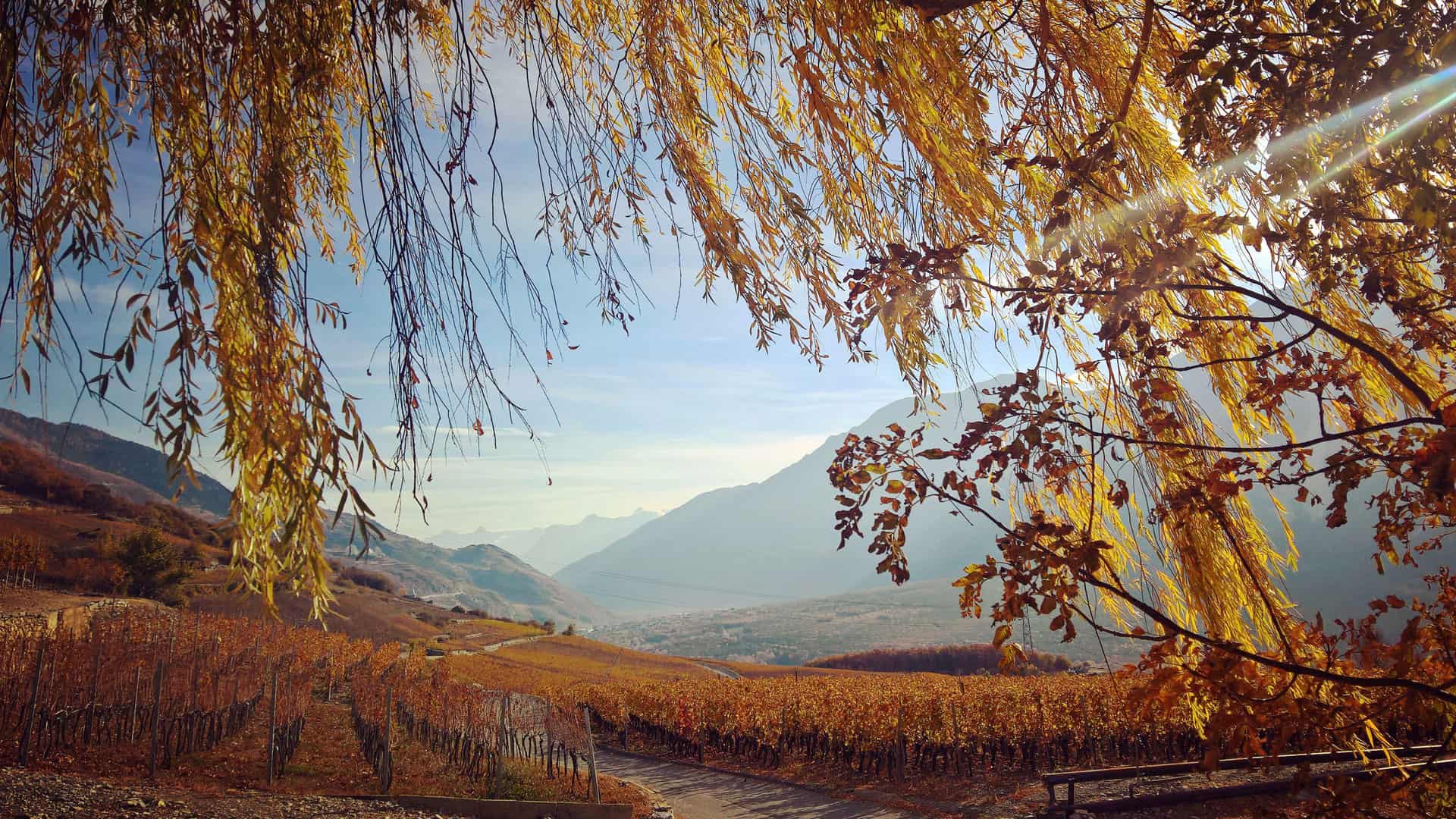
october
The time has come for the harvest; the winegrower can reap the first fruits – in the truest sense of the word – of his hard work. The leaves begin to change color, the sign that the grapes have reached full ripeness. Depending on the weather and temperatures, the moment of wimden can vary greatly in time. The hard-working vineyard workers now set about the last big piece of work. The grapes must be harvested in dry weather if possible, as the rain lowers the must weight by up to 6o Oechsle. The grapes are harvested separately, i.e. the healthy berries are separated from the diseased ones.
november
While the noble juice of the grapes is being processed to its best in the wine cellar, the vines lose their leaves and go into hibernation. The winegrower uses this time to carry out earthworks, clearing, inspections and repairs in the vineyard. Integrated production also requires the preservation and maintenance of the landscape in the vineyard. The vineyard and its immediate surroundings provide an important habitat for many animal species, including valuable beneficial insects and various plant species. These very diverse biotopes are also an integral part of the winegrowing landscape. Special attention must be paid to the maintenance of existing biotopes and the creation of new zones with a rich biodiversity. Before the onset of winter, old plants are removed and the soil is prepared for new plantings in the spring.
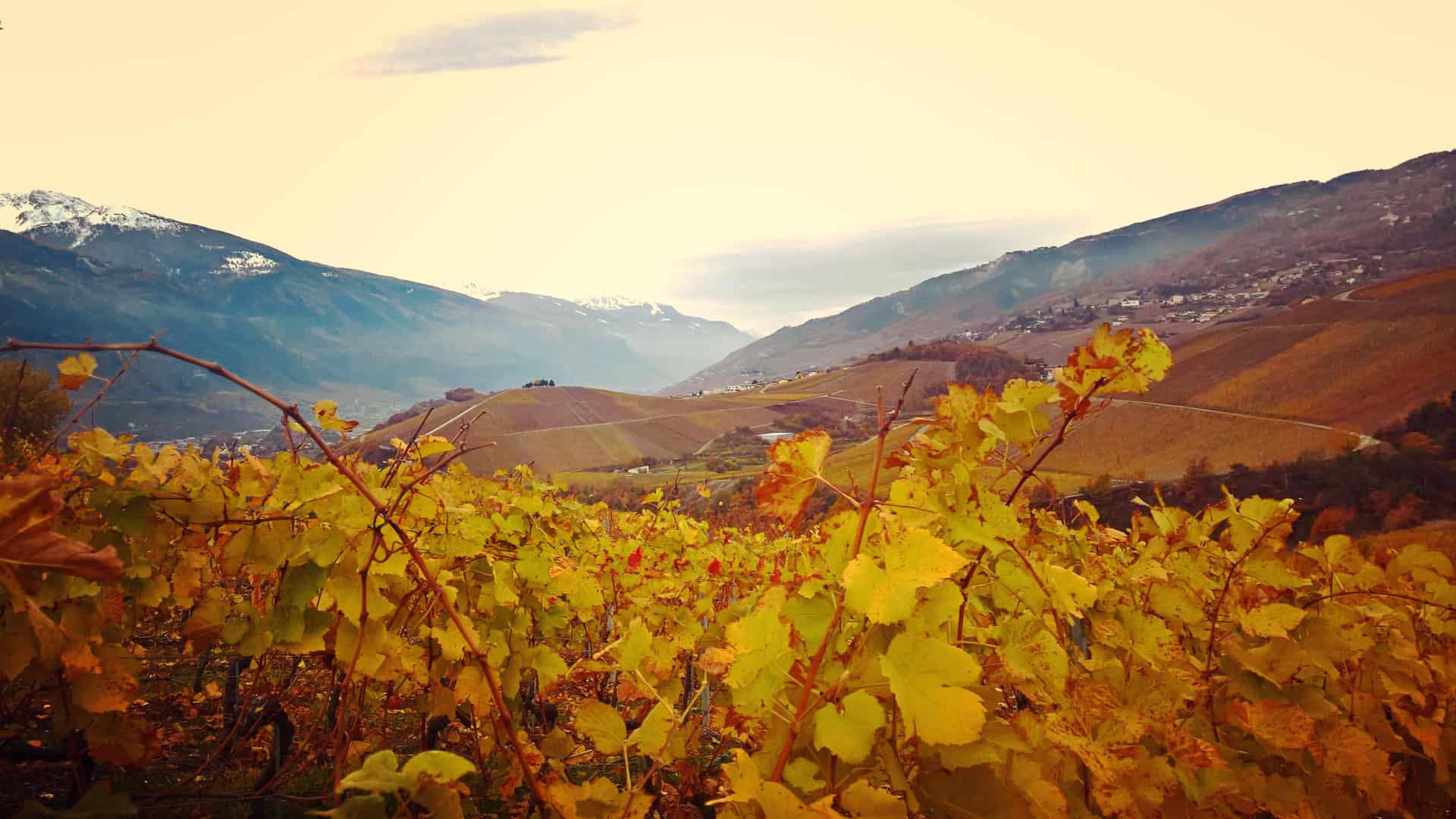
December
Winter has finally arrived and with it the cold and snow. It is generally too wet for soil work, which is usually completed in January. There is time to purchase new materials and tools, analyze the soil samples in detail and draw up an action plan for the coming wine year.
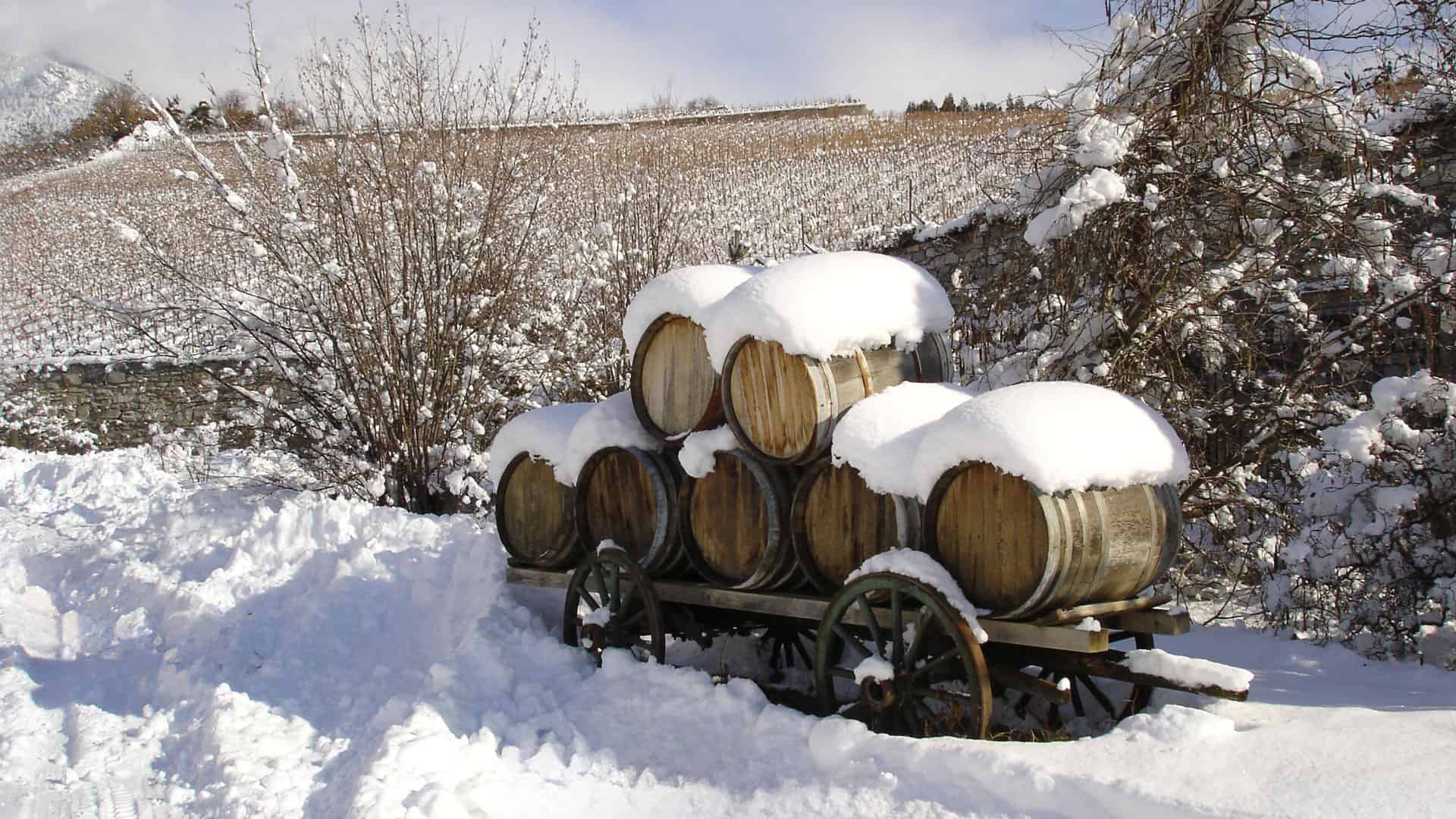
FAQ:
When does the grape year begin?
The beginning of a calendar vine year is January and the vine year ends in December. Basically, however, there is neither a beginning nor an end to the year, as the work in the vineyards is cyclical and recurring over the course of the year. And even when the grape harvest is complete and winter has arrived after the fall, when the vines in the vineyards go into hibernation, there is still a lot of work for the winegrower to do. After the grape harvest, this work is mainly concentrated in the cellar, where the future quality and characteristics of the wine can be influenced during the ageing process.
Why is it important for the grapes to ripen that the leaves are removed?
In order for the grapes to ripen optimally in the various locations, it is important from a certain point in time and with regard to the grape harvest that the foliage is at least thinned out. The foliage can either influence the sunlight and thus the process of sugar formation in the grapes. On the other hand, the foliage can absorb moisture when it rains and pass this on to the grapes, so that there is a risk of rotting. This can have a negative impact on the grape harvest in the fall and the quality of the grapes.
How often does the winegrower have to look after the vineyards each year?
The winegrower must take care of his vineyards and sites throughout the year. It is important that the winegrower takes care of the vines in the vineyards so that the grapes are of perfect quality at the time of harvest and can later be vinified into sophisticated wine in the cellar.
What happens in the vine year at the time of flowering?
In early spring, at the time of flowering, the vine begins to grow and form inflorescences. Each inflorescence then becomes a cluster of grapes. Each individual flower must be pollinated in order to become a grape berry. Unlike other plants, vines are self-pollinating and therefore do not need to attract insects. Without the blossom, there would be no grape harvest.
How does the winegrower ensure bird protection?
Bird protection is an important point to protect the ripe grapes from birds shortly before the grape harvest. There is a whole range of measures. The most effective bird protection is certainly the use of nets, also known as vine nets. Other possible means of bird protection include the use of scarecrows. Colorful fluttering ribbons can also be used as visual bird protection, or the winegrower can use acoustic devices for bird protection, which emit bird cries and are intended to keep birds that like to eat ripe berries away from the outset.
Why are the shoots removed in May?
In May, the winegrower removes the shoot or shoots for the purpose of later harvest regulation. Now, in spring, the shoots and shoots grow rapidly. If the individual shoots were not removed, a large yield of lower quality would be achieved during the grape harvest in the fall. This is not desirable, which is why the so-called “torture” of the vines takes place, in which the superfluous shoots are removed. This work step of removing the unwanted shoots is a very important part of the care in May and serves to regulate the harvest in order to produce a wine in the fall whose quality can be described as exquisite.
What influence does the weather have on the harvest and the quality of the wines?
The weather determines the course of the weather in the vine year and therefore has the greatest influence on the growth of the vines, the flowering, the development of the berries and therefore also on the grape harvest, also known as the grape harvest. Weather that is too cold slows down the growth of the vine and the grapes. The berries cannot ripen sufficiently and the acidity remains too high. Weather that is too warm, on the other hand, carries the risk of premature ripening and harvesting, in which the berries have an imbalance of acidity and sugar. Rainy weather can lead to fungal diseases, wash out the soil and lead to a dilution of the aroma in the grapes, which also has an unfavorable effect on the harvest.
Why is midsummer in July and August also known as Véraison?
In the middle of a vine year, decisive events take place in the rows of vines. In July and August, the grapes have grown so large that they can begin to ripen. This process begins in July and August with the véraison. This is the time when the grapes lose their skin. Initially still green, a white grape then turns golden yellow, a dark grape first turns red and then purple. Véraison in July and August is crucial for ensuring that ripe grapes can be harvested in the fall.
Why are the shoots tied to the wire?
Shoots, also known as shoots, are tied to a wire as part of the winegrower’s care of the vineyard so that the winegrower can determine the later direction of growth. The shoots are tied to the wire so that the shoot can continue to grow upwards in the desired direction in order to form the grapes later. Tying is also called looping or pinning. This process takes place every time the shoots reach the next higher stapling wire, they are then looped or stapled.
Does the work in the vineyard affect all rows and all varieties?
Yes, the work in the vineyard affects all rows of vines and must be carried out regardless of the variety. There are varieties that are less susceptible to external weather influences, but there are also a whole range of varieties that react very sensitively to the slightest inconsistencies. The winegrower must therefore undertake a great deal of work in all locations and vineyards if he wants to ensure that he can harvest the desired quantity of wine in the desired quality in September and October, when the grape harvest is due.

